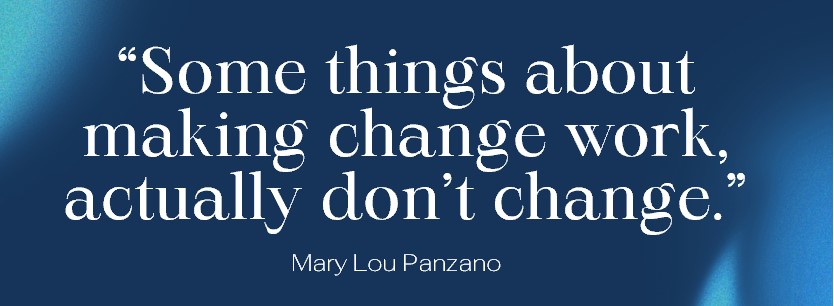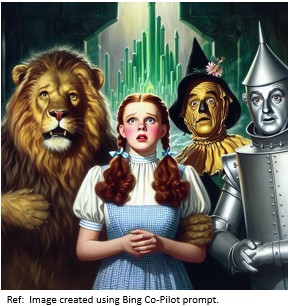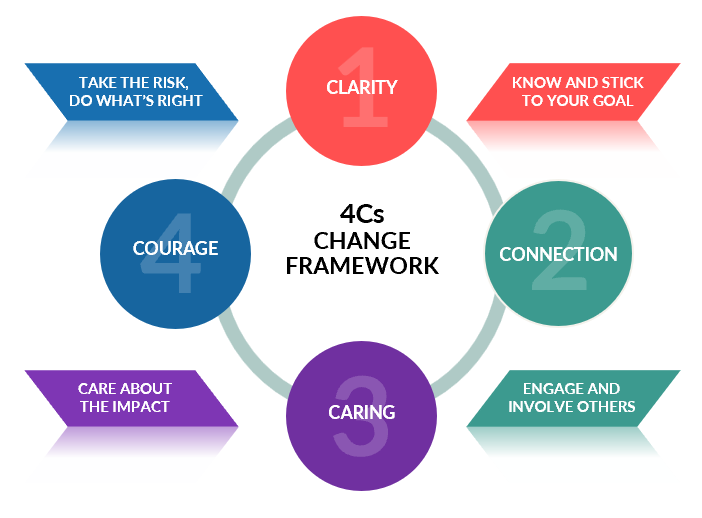When Larry Prince, CEO, Prince Leadership, used a well-known and beloved movie to talk about leadership at a workshop he led recently, it made me realize that the topic I speak about and teach has deep roots and lasting relevance. The movie he mentioned was first released in 1939 and adapted from a book written in 1900.
Larry works with clients to grow revenue, lead stronger teams, and run the business more easily. I’m on the Board of one of the non-profits he works with and find his counsel and guidance to be first-rate. His workshop was about how to build a rock star leadership team.
One analogy he used referenced a character in this 1939 movie, noting how they demonstrated one of the most important things leaders do — instill belief in the team.
As I reflected on that concept, I thought about work I do to help people make change work for them using my proprietary 4Cs Change FrameworkTM and The 12 Principles of Prosperity I developed, which bring that framework to life.
The 4Cs Change FrameworkTM and the 12 Principles of Prosperity are based on the success formula outlined in the book, Think and Grow Rich, by Napoleon Hill, written in 1937. Isn’t it interesting how the teachings in that book, which are designed to enable anyone to achieve anything they desire, are still used and relevant today? That’s credibility.
Back to the movie reference. Let me describe the scene Larry used as an example of strong leadership and then I’ll talk about my 4Cs Change FrameworkTM is applied to it.
Why am I going back more than 80 years to make a point? Because it’s important to understand that some things about making change work, actually don’t change.

The movie I’m talking about is, The Wizard of Oz. The scene referenced in Larry’s workshop is the one where the four main characters, Dorothy, Scarecrow, Tin Man and Lion are in front of the Wizard in the Emerald City. The team of four returns the Wizard, bringing him the broomstick of the Wicked Witch of the West, as he asked them to do as a condition of granting them their wishes.

The Wizard is behind a curtain using scare tactics to intimidate them. At first, he says he wants to consider the matter further. Then each one musters up the courage to challenge him, with Dorothy saying that a great and powerful wizard would keep their promises.
Think about that. How many leaders have you encountered who didn’t keep their promises?
The team is quite upset. After all they went through to get the broomstick, as asked – risking their lives — they are not getting the reward promised them and are told to come back tomorrow. How often have you been disappointed in a similar way?
Meanwhile, Dorothy’s little dog, Toto, sniffs out the Wizard and reveals him behind the curtain. The Wizard is now exposed. Dorothy calls him a very bad man. He sheepishly replies that while he is a very good man, he’s just a bad wizard.
It isn’t until the Wizard steps out from behind the curtain and faces his team directly, does he begin to do exactly what he promised. And that is, he instills belief in each of them by telling them that they have had in them all along access to that which they seek – a brain, a heart, the courage, a home.
That power of belief in oneself is one of the most motivating forces that drives action toward achieving what you want. And it’s one of the Principles that supports my 4Cs Change FrameworkTM. To demonstrate how the movie connects here, let me briefly describe my 4Cs Change FrameworkTM:

- Clarity – Know and stick to your goal.
- Connection – Engage and involve others in pursuit of your goal.
- Caring – Care about the impact of what you’re doing has on others.
- Courage – Take the risk, do what’s right. Nothing happens if nothing happens. You need to act in order to get what you want out of life.
Now, let me bring this home (pardon the pun) and apply my 4Cs Change Framework to The Wizard of Oz. I’ll use Dorothy as the main character to illustrate the 4Cs in action, but if you have a think on it, you’ll see how it applies to every character who gets what they desire in the movie.
- Clarity. Almost as soon as Dorothy arrives in Munchkin land, the first thing she wants to do is get back home. There is no question throughout the movie, from that point forward, what Dorothy wants – to go home. Crystal clear.
- Connection. The townspeople in Munchkin land befriend Dorothy, and knowing what her goal is, they recommend she travel to the Emerald City to ask the Wizard for help. Glinda, the Good Witch, appears to help as well, giving her Ruby Slippers to keep her safe from the Wicket Witch. As Dorothy begins her journey down the yellow brick road, she engages and involves Scarecrow, Tin Man, and Lion along the way to help her get to the Emerald City. In return, Dorothy shares the opportunity with them to ask the Wizard to grant them their wishes, too.
- Caring. Even with their own issues and wishes, each character demonstrates how much they care about each other, and the impact their actions in pursuit of what they wanted, had on the others. There are many examples of how each one supported the other as they first visit with the Wizard, go through life-threatening challenges to bring back the broomstick of the Wicked Witch, and support each other when facing the Wizard when they returned. Even at the end, each character expresses how much they will miss the others now that they have gotten their wishes granted.
- Courage. This is seen throughout the movie, but especially when working as a team to find a way to get the broomstick of the Wicked Witch to the Wizard as he asked. They all took enormous risks, stepping way out of their comfort zones, worked together, and did what they had to do to help get Dorothy home. I turn, their efforts and risk-taking paid off — as it always does. If you achieved your goal, great! If you didn’t, you learned something.
There are many examples in this movie, other movies, at work and in life where you may have seen my 4Cs Change FrameworkTM work to make change happen to achieve what’s desired.
With so much changing around us all the time it’s comforting to know that some things about making change work, actually don’t change.
If you’re interested in learning more about how you can apply my 4Cs Change FrameworkTM at work, with your team, or in your life, let’s talk.
To your prosperity!

